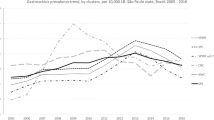Abstract
OBJECTIVE: Gastroschisis is a congenital anomaly that has been reported to be increasing in frequency. The objective of this study was to determine the birth prevalence of gastroschisis using two large databases.
STUDY DESIGN: We reviewed data from a statewide database and a national database from a neonatal health care provider, abstracting cases of gastroschisis.
RESULTS: In North Carolina, the birth prevalence of gastroschisis increased from 1.96 per 10,000 births in 1997 to 4.49 per 10,000 births in 2000 (p=0.0007). The overall increase was almost entirely because of the increase in infants born to mothers less than 20 years old. Among infants receiving care from the national neonatal provider, the prevalence of gastroschisis increased from 2.9 per 1000 patients in 1997 to five per 1000 patients in 2001 (p=0.044).
CONCLUSION: The birth prevalence of gastroschisis is increasing in North Carolina, and this trend may be occurring nationally. The rapid change in the birth prevalence in the subset of population most at risk for gastroschisis implicates environmental or pharmacologic teratogens rather than changing population characteristics as a causal factor in the development of gastroschisis.
This is a preview of subscription content, access via your institution
Access options
Subscribe to this journal
Receive 12 print issues and online access
$259.00 per year
only $21.58 per issue
Buy this article
- Purchase on Springer Link
- Instant access to full article PDF
Prices may be subject to local taxes which are calculated during checkout
Similar content being viewed by others
References
Kitchananan S, Patole SK, Muller R, Whitehall JS . Neonatal outcome of gastroschisis and exomphalos: a 10-year review. J Paediatr Child Health 2000;36:428–430.
Driver CP, Bruce J, Bianchi A, Doig CM, Dickson AP, Bowen J . The contemporary outcome of gastroschisis. J Pediatr Surg 2000;35(12):1719–1723.
Dimitriou G, Grennough A, Mantagos JS, Davenport M, Nicolaides KH . Morbidity in infants with antenatally-diagnosed anterior abdominal wall defects. Pediatr Surg Int 2000;16:404–407.
Rankin J, Dillon E, Wright C . Congenital anterior abdominal wall defects in the north of England, 1986–1996: occurrence and outcome. Prenatal Diagn 1999;19(7):662–668.
Penman DG, Fisher RM, Noblett HR, Soothill PW . Increase in incidence of gastroschisis in the South West of England in 1995. Br J Obstet Gynaecol 1998;105:328–331.
Nichols CR, Dickinson JE, Pemberton PJ . Rising incidence of gastroschisis in teenage pregnancies. J Matern Fetal Med 1997;6(4):225–229.
Suita S, Okamatsu T, Yamamoto T, et al. Changing profile of abdominal wall defects in Japan: results of a national survey. J Pediatr Surg 2000;35(1):66–71.
Bugge M, Holm NV . Abdominal wall defects in Denmark, 1970–89. Paed and Perinatal Epidemicol 2002;16:73–81.
Forrester MB, Merz RD . Epidemiology of abdominal wall defects, Hawaii, 1986–97. Teratology 1999;60:117–123.
Torfs CP, Katz EA, Bateson TF, Lam PK, Curry CJ . Maternal medications and environmental exposures as risk factors for gastroschisis. Teratology 1996;54(2):84–92.
Werler MM, Mitchell AA, Shapiro S . First trimester maternal medication use in relation to gastroschisis. Teratology 1992;45:361–367.
Drongowski RA, Smith RK, Coran AG, Klein MD . Contribution of demographic and environmental factors to the etiology of gastroschisis: a hypothesis. Fetal Diagn Ther 1991;6:14–27.
Martinez-Frias ML, Rodriguez-Pinilla E, Prieto L . Prenatal exposure to salicylates and gastroschisis: a case–control study. Teratology 1997;56:241–243.
Werler MM, Sheehan JE, Mitchell AA . Maternal medication use and risks of gastroschisis and small intestinal atresia. Am J Epidemiol 2002;155(1):26–31.
Torfs CP, Lam PK, Schaffer DM, Brand RJ . Association between mothers' nutrient intake and their offspring's risk of gastroschisis. Teratology 1998;58(6):241–250.
Author information
Authors and Affiliations
Rights and permissions
About this article
Cite this article
Laughon, M., Meyer, R., Bose, C. et al. Rising Birth Prevalence of Gastroschisis. J Perinatol 23, 291–293 (2003). https://doi.org/10.1038/sj.jp.7210896
Published:
Issue Date:
DOI: https://doi.org/10.1038/sj.jp.7210896
This article is cited by
-
Predicting birth weight in fetuses with gastroschisis
Journal of Perinatology (2018)
-
Trends in incidence and outcomes of gastroschisis in the United States: analysis of the national inpatient sample 2010–2014
Pediatric Surgery International (2018)
-
Disparity in access and outcomes for emergency neonatal surgery: intestinal atresia in Kampala, Uganda
Pediatric Surgery International (2017)
-
The epidemiology, prevalence and hospital outcomes of infants with gastroschisis
Journal of Perinatology (2016)
-
Chlamydia trachomatis IgG3 seropositivity is associated with gastroschisis
Journal of Perinatology (2015)


